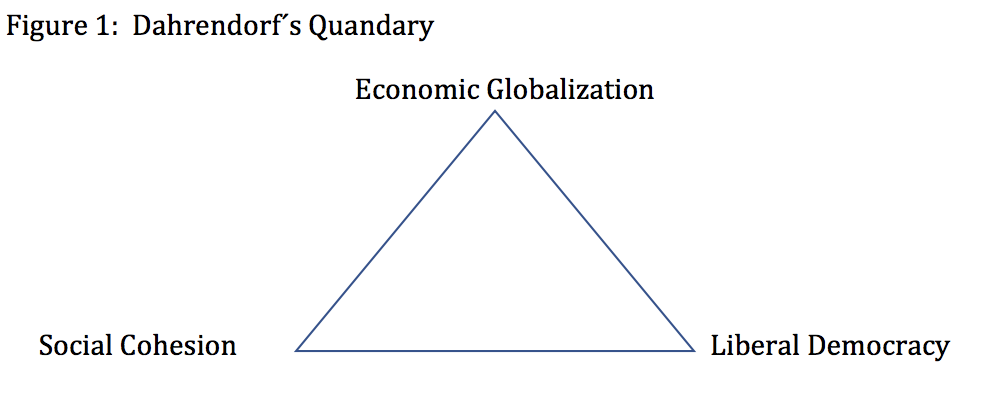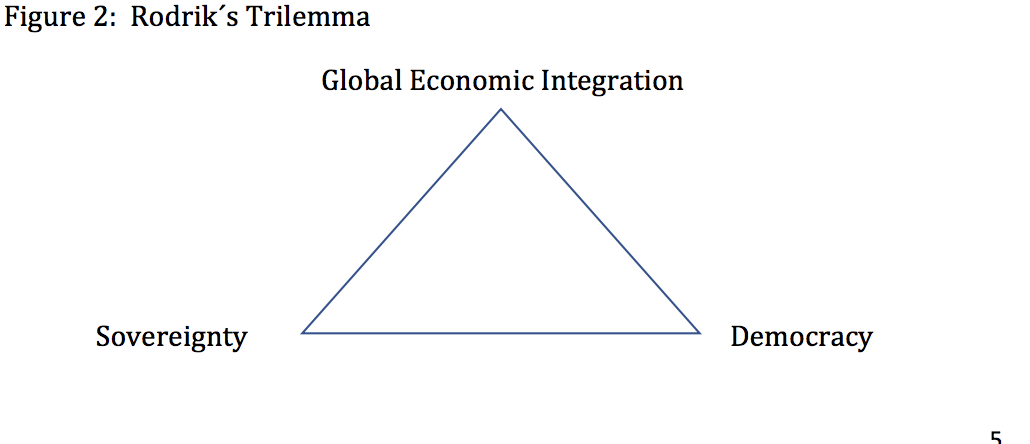In a number of G20 countries, the combination of increasing economic inequality and decreasing social mobility is leading to a situation of social arrest, a paralysis fed by deep structural blockages in society. Social arrest is the result of a decades-long neglect in addressing the consequences of a globalization process by decoupling economic and social policy. The wider implications of social arrest can be understood in the context of the Dahrendorf Quandary and the Rodrik Trilemma, which posit that liberal democracy, national sovereignty and global economic integration become at some point incompatible. Their relationships require careful balancing through forward-looking policies aimed at managing inherent tensions. Reviewing a range of policy approaches to counteract social arrest tendencies, five key measures are proposed to recouple economic and social policies: tax reforms to reduce income inequality and wealth disparities; social mobility programs to function as “social conveyor belts;” safety shields for populations most exposed to globalization pressures, including managed migration; an enabling environment for civil society to boost self-organization and conflict management; and sustained debates and social engagements for bringing disconnected publics closer.
Challenge
Politicians and policy experts are beginning to realize the full implications of two distinct but related developments: first, there are persistently high and higher degrees of economic inequality to the extent that many societies are more unequal today than they were before deregulation and the economic globalization spurt of the 1980s (Atkinson, 2015; World Inequality Report 2018). Over the last several decades, income inequality has increased significantly in North America, China, India and Russia, risen more moderately in most European countries, and remained mostly stable but locked at very high levels in the Middle East, Sub-Saharan Africa, and Latin American countries like Brazil (World Inequality Report 2018: 5, 6).
Second, and during the same period, social mobility has decreased (Chetty 2017; Major and Machin 2018: 27-31, footnote 7 for additional sources), making it less likely for individuals to advance economically as well as socially. Inter-generational mobility, too, has dropped in major market economies, suggesting that children are less likely to surpass their parents in terms of economic and social well-being. What is more, declining mobility patterns tend to concentrate geographically, leading to pronounced disparities between prospering and failing regions within countries.
Analysts and politicians are trying to make sense of this kind of “social arrest” or paralysis that appears to have taken hold of advanced market economies, and that in the past seemed more characteristic of stalled societies in the Middle East, Africa or Latin America. Social arrest is the likely outcome when the two developments, increasing inequality and decreasing social mobility, are left unattended for long: jointly, both developments lead to societies with greater inequity, stifling social and economic advances for a significant and growing portion of the population.
This is the situation in growing number of OECD countries: the United States, the United Kingdom, Australia, and Canada, with similar tendencies in several EU member states like France, Germany, and Italy (see Major and Machin 2018: 34-38) as well as other developed market economies. Social arrest describes a deep structural blockage of society resulting from a disconnect between economic and social policy: while societies are becoming economically more developed and wealthier, the benefits of such richness and opportunities for advancement are increasingly shared more unequally.
In a way, in terms of their social development, such societies seem to be going backwards: a new kind of precariat is emerging, fed by downward social mobility, and characterized by status anxiety as well as growing disillusionment and resentment. They risk becoming deeply divided in their social fabric, culture, and, ultimately, also in terms of politics. The rise of populism, authoritarianism and neonationalist tendencies are likely linked to persistent social arrest patterns.
Unchecked Decoupling Leading to Social Arrest
How could it happen that the last three decades of economic globalization were accompanied by greater inequality and lower social mobility? From the 1970s onward, there might indeed have been good reasons for deregulation and lowering trade barriers, for pro market policies generally, and welfare state reforms in particular: with Thatcherite and Reaganite policies as prime exemplars, structural reforms were needed to increase competitiveness, to reduce the power of entrenched interests, and, for countries with declining manufacturing, a switch to a service-based economy had to be facilitated.
However, these policies were often implemented without adequate regard to the wider social changes they could trigger in society in the medium to longer term. Yet according to prevailing thinking among neo-liberal economists at that time, these were mere side effects waiting to be corrected by market forces. As a result, few heeded the advice of political economists like Garrett (1998) and sociologists like Dahrendorf (1995). They argued already in the 1990s that only countries actively shielding their populations from the effects of economic globalization would reap its benefits in the long-run.
Some countries like Germany or Sweden have taken this more to heart than others like the United States and Britain, as they tried to balance economic globalization and domestic policy challenges. So, to understand the tendencies towards social arrest today, we have to look back over nearly 40 years of policymaking. According to Snower (2018), the policy stance was supported by an ideology facilitating a general process of decoupling, the gradual divorce of the economic from the social. It is the result of neo-liberal social science thinking, soon carried over into politics and policies, which assumed that peoples´ values and normative aspirations, their identities and communal needs, matter less than economic rationality and the efficiency of markets.
Yet there is now overwhelming evidence that economic globalization has been accompanied by a pattern of greater inequality and lower social mobility in several major market economies (Chetty 2017; Major and Machin 2018). Note that even moderately high levels of inequality do not necessarily create deep structural problems for society as long as they are roughly matched by prevailing social mobility levels. But when tendencies towards social arrest set in, we have a process of “inequalization…, building paths to the top for some and digging holes for others, creating cleavages, splitting” Dahrendorf 1995:9). Typically, social arrest manifests itself in profound regional disparities as well, creating large urban and rural areas left behind the thriving metropolises.
Dahrendorf´s Quandary and Rodrik´s Trilemma
It is useful to put the problem of social arrest into a broader framework for understanding how it develops and what can be done about it. In essence, the decoupling of the economic from the social in recent decades is part of a set of challenges facing developed market economies. At the height of the 1990s globalization spurt, Dahrendorf (1995) argued that a growing world economy creates “perverse choices” for liberal democracies: staying competitive requires either adopting measures detrimental to the cohesion of civil society, or restricting civil liberties and political participation. For OECD countries, the task ahead for the early 21st century, he writes, “is to square the circle between growth, social cohesion and political freedom (1995:4).”
This challenge become known as the Dahrendorf Quandary (Buti and Pichelmann 2017). For Dahrendorf, the global financial crisis and its aftermath proved that many countries seem to have failed at finding a solution. He would have agreed with Snower (2918) that failure to balance growth, social cohesion and political freedom is linked to decoupled policies. For many OECD countries did not even try to balance the push and pull of economic, political and social developments because neoliberal policies since the 1980s favored the economic corner of Dahrendorf´s Quandary (Figure 1).

Writing shortly after the global financial crisis, which proofed the greatest stress test for the global economy since World War II, and continues to strain the social fabric and political systems of many OECD countries, Dani Rodrik (2011) suggested a version of the Quandary, the Rodrik Trilemma (Figure 2). Phrased as an impossibility theorem, it posits that “that democracy, national sovereignty and global economic integration are mutually incompatible: we can combine any two of the three, but never have all three simultaneously and in full” (Rodrik 2011 weblog).

It seems that Dahrendorf and Rodrik have pointed to a fundamental challenge of modern societies, the incompatibility of the underlying drivers involved — and the asynchrony of the ensuing processes and their impacts on societies in terms of inequalities and opportunities. The economic drivers of globalization, decoupled and operating in transnational space, undermine the nation state, hence national sovereignty, and in turn, democracy through loss of legitimacy. Nativist economic strategies may strengthen the nation state, even democracy, but lessen economic growth. Inherent are grave dangers, be they left or right populism mixed with identity politics, as Rodrik suggests, or, as Dahrendorf put it, the growing authoritarian temptations of divided societies.
Proposal
What can be done?
The Dahrendorf Quandary and the Rodrik Trilemma are statements about sovereign nation states that are to varying degrees integrated in the global economy and have some kind of liberal democracy in place. From a policy perspective, the challenge becomes how to manage the inherent tensions in the Quandary and the Trilemma, assuming that no optional solution can be found.
Rodrik advocates a re-balancing of globalization towards national governance, or forming regional coalitions among countries like the European Union. In other words, the main response to social arrests due to decoupling is a taming of globalization forces, at least temporarily, under the primacy of the national interest or smart pooling of sovereignty. Regained sovereignty could then provide the political space to implement measures aimed at reducing inequality and enhancing mobility.
Specific about the Quandary is the emphasis on social cohesion, civil society, and liberty. Dahrendorf (1994) argued that while liberal democracies are conflict prone they are also better at managing conflicts and hence more resilient than other forms. Yet herein lies the problem: civil society – a major engine of conflict management to produce social cohesion in liberal democracies – is weakening through economic globalization and loss of sovereignty. Civil society expresses the capacity of society for self-organization and the potential for peaceful, though often contested, settlement of diverse private and public interests (see Keane 1998: 6; Gellner 1994: 5).
Can societies regain and maintain this capacity needed to counter-balance the pressures of markets and authoritarian temptations? Dahrendorf (1995) offered – in his words – “six modest proposals.” Slightly reformulated, they include: anticipating changes in the work place and prepare affected population groups for them; undercutting the supply route for the precariat; strengthening local communities and regions in danger of being cut off; creating a stakeholder economy; adjusting government responsibilities and budgetary priorities to what´s possible; and changing public discourse to encourage a broad debate of the tensions inherent in the Quandary.
Whereas Dahrendorf´s vision of the way forward is that of liberal market policies under a smart, forward-looking and realistic government and a vibrant civil society, Buti and Pichelmann (2017) offer a more social democratic perspective. They propose to realign the social and the economic with a “prosperity model” that has three main pillars (stability, efficiency and fairness) and five main policy levers: improving the quality of public spending; better management of competitive markets; investing in education and training; implementing modernized tax-benefit systems; and maintaining labor security while strengthening work place flexibility.
Snower (2018) seems closer to Dahrendorf than to Buti and Pichelmann. He advocates a realignment of markets and society through a systematic recoupling of economic and social policy (see also Kelly and Sheppard 2018). His approach includes three main pillars as well but puts more emphasis on the political: wealth, empowerment, and solidarity. Wealth stands for macroeconomic management that combines traditional economic policymaking with social welfare measures; empowerment is about giving people voice and control over their fate; and solidarity addresses the broader needs of humans as social creatures, and especially a strengthening of communities.
Policy Recommendations
Decades of decoupled policies are responsible for the social arrest patterns we observe in developed market economies today. The tensions inherent in both the Quandary and the Trilemma were simply not well managed, if at all. It is time to implement measures that improve tension management and hence reverse social arrest tendencies. Some measures such as tax reforms to reduce economic inequality can show results in short to medium terms. Others that aim at increasing social mobility may take at least one generation to show significant impact, even though the effects on people´s aspirations and political preferences might come much sooner, including greater civic engagement.
Clearly, there is much overlap among the proposals above. While Rodrik seems to favor a managed reduction of economic globalization by strengthening sovereignty, Dahrendorf, Buti and Pichelmann as well as Snower offer a wider set of measures. Of course, for these to be more than technocratic policy measures, they require political framing and normative foundations. Any such framework positioned along a liberal market to social democratic continuum would involve five core policy measures for managing tensions and achieving recoupling. These are:
1. tax reforms to reduce income inequality and wealth disparities, and to incentivize economic mobilization in terms of entrepreneurship and employment;
2. social mobility programs to function as “social conveyor belts,” likely to include massive investments in education and skills training in the broadest sense to boost employability, and measures to create more equal opportunities for younger generations;
3. safety shields for populations most exposed to, or likely to be negatively affected by, globalization pressures, and policies to compensate for regional disparities including managed migration at domestic and international levels;
4. creating an enabling environment for civil society for strengthening selforganization; and
5. encouraging sustained debates among disconnected publics to enhance social cohesion.
For addressing social arrest, tax reforms and social mobility programs are needed to realign levels of social inequality with the range of opportunities for different socio-economic groups. Safety shields, regional policy and migration management are required to undercut the formation of a precariat and to staff off inter-generational downward social mobility. An enabling environment for civil society contributes to conflict management and reduces authoritarian tendencies, while reinvigorated public debates can help heal current divides and prevent new ones from emerging.
References
• Atkinson, Anthony. Inequality: What can be done. Cambridge, MA: Harvard University Press, 2015.
• Buti, M. and K. Pichelmann. European integration and populism: addressing
• Dahrendorf’s quandary. Rome, LUISS: School of European Political Economy. Policy paper, 2017.
• Chetty, R. The Fading American Dream: Trends in Absolute Income Mobility Since 1940. (with D. Grusky, M. Hell, N. Hendren, R. Manduca, J. Narang), Science 356 (6336): 398-406, 2017.
• Dahrendorf, R. Der moderne soziale Konflikt. Essay zur Politik der Freheit. Munich: DTV, 1994.
• Garrett, G., Global Markets and National Politics: Collision Course or Virtuous Circle?, International Organization 52(4), 1998: 149-176.
• Gellner, E. Conditions of liberty: Civil society and its rivals. London: Hamish Hamilton, 1994.
• Keane, J. Civil society: old images, new visions. Stanford University Press, 1998.
• Kelly C. and B. Sheppard, “Realigning Business, Economies and Society” G20-Insights (https://www.g20-insights.org/policy_briefs/realigning-business-economiessociety/), 2018
• Major L.E and S. Machin. Social Mobility and Its Enemies. London: Pengiun, 2018
• Rodrik, D. The globalization paradox: Democracy and the future of the world economy. New York: W.W. Norton, 2011. See also: http://rodrik.typepad.com/dani_rodriks_weblog/2007/06/the-inescapable.html
• Snower D. J. (2018). Beyond capital and wealth. Economics: The Open-Access, OpenAssessment E-Journal, 12 (2018-21): 1–10.http://dx.doi.org/10.5018/economicsejournal.ja.2018-21, 2018.
• World Inequality Report 2018. Edited by Facundo Alvaredo, Lucas Chancel, Thomas Piketty, Emmanuel Saez, and Gabriel Zucman. Cambridge, MA: Belknap / Harvard University Press, 2018.








